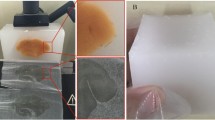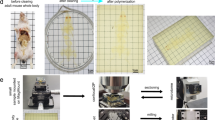Abstract
SINCE the introduction of thin sectioning by conventional methods for electron microscopy in 1948 1, several embedding techniques have been described1,2. In one of these, namely, double embedding in nitrocellulose and paraffin, the tissue is first infiltrated with an ether–alcohol solution of nitrocellulose ; the volume occupied by the solvent is then filled with molten paraffin. The chief disadvantage of this method is the slowness of infiltration of the viscous nitrocellulose. In addition, the hardness of the block cannot easily be controlled to suit the hardness of the material to be cut. The second method in common use consists in embedding the material in a plastic such as butyl methacrylate, which is then polymerized in the temperature range 50°–60° C. for 12–24 hr. to form a hard mass. We find, however, that the polymerization is difficult to control. The hardness is governed by the degree of polymerization, and the cutting qualities are quite sensitive to hardness. Furthermore, the hardness appears to increase with time, making storage of the blocks impractical.
This is a preview of subscription content, access via your institution
Access options
Subscribe to this journal
Receive 51 print issues and online access
$199.00 per year
only $3.90 per issue
Buy this article
- Purchase on Springer Link
- Instant access to full article PDF
Prices may be subject to local taxes which are calculated during checkout
Similar content being viewed by others
References
Pease, D. C., and Baker, R. F., Proc. Soc. Exp. Biol. Med., 67, 470 (1948).
Newman, Borysko, and Swerdlow, J. Research Nat. Bur. Stand., 43, 183 (1949).
Baker, R. F., Modern, F. W. S., and Warren, O. (in the press).
Author information
Authors and Affiliations
Rights and permissions
About this article
Cite this article
BAKER, R., WARREN, O. Simplified Embedding of Biological Material for Thin Sectioning. Nature 169, 420–421 (1952). https://doi.org/10.1038/169420b0
Issue Date:
DOI: https://doi.org/10.1038/169420b0
This article is cited by
-
Die Ultrastruktur von Wurzelmeristemzellen der Erbse (Pisum sativum)
Protoplasma (1958)
Comments
By submitting a comment you agree to abide by our Terms and Community Guidelines. If you find something abusive or that does not comply with our terms or guidelines please flag it as inappropriate.



